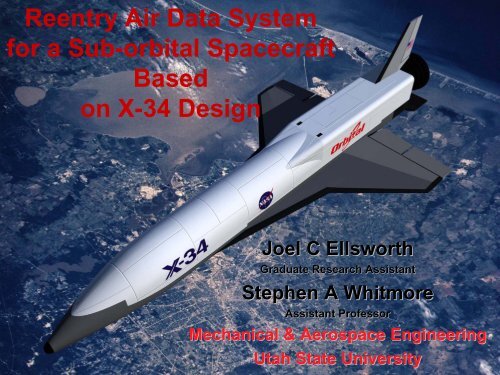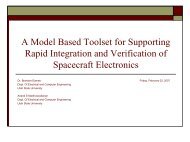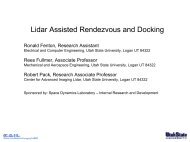Reentry Air Data System for a Sub-orbital Spacecraft Based on X-34 ...
Reentry Air Data System for a Sub-orbital Spacecraft Based on X-34 ...
Reentry Air Data System for a Sub-orbital Spacecraft Based on X-34 ...
You also want an ePaper? Increase the reach of your titles
YUMPU automatically turns print PDFs into web optimized ePapers that Google loves.
<str<strong>on</strong>g>Reentry</str<strong>on</strong>g> <str<strong>on</strong>g>Air</str<strong>on</strong>g> <str<strong>on</strong>g>Data</str<strong>on</strong>g> <str<strong>on</strong>g>System</str<strong>on</strong>g><br />
<str<strong>on</strong>g>for</str<strong>on</strong>g> a <str<strong>on</strong>g>Sub</str<strong>on</strong>g>-<str<strong>on</strong>g>orbital</str<strong>on</strong>g> <str<strong>on</strong>g>Spacecraft</str<strong>on</strong>g><br />
2007 USU Industry Day<br />
<str<strong>on</strong>g>Based</str<strong>on</strong>g><br />
<strong>on</strong> X-<strong>34</strong> Design<br />
Joel C Ellsworth<br />
Graduate Research Assistant<br />
Stephen A Whitmore<br />
Assistant Professor<br />
Mechanical & Aerospace Engineering<br />
1<br />
Utah State University
2007 USU Industry Day<br />
Background<br />
• Several companies have been <str<strong>on</strong>g>for</str<strong>on</strong>g>mulated during the past<br />
decade with the intenti<strong>on</strong> of developing a sup-<str<strong>on</strong>g>orbital</str<strong>on</strong>g> space<br />
tourism market. These companies include Okalahoma City<br />
based Rocketplane-Kistler, Roswell New Mexico based<br />
Virgin Galactic, and San Diego based Bens<strong>on</strong> Space<br />
Company am<strong>on</strong>g others.<br />
• Most designs are intended to glide back to earth after<br />
using a rocket engine to boost themselves out of the<br />
atmosphere.<br />
2
2007 USU Industry Day<br />
Background c<strong>on</strong>t.<br />
• Regardless of the particular design features or missi<strong>on</strong><br />
operati<strong>on</strong>s these trans-atmospheric vehicles are generally<br />
more aircraft than spacecraft<br />
• <str<strong>on</strong>g>Air</str<strong>on</strong>g>-mass reference measurements are required <str<strong>on</strong>g>for</str<strong>on</strong>g> flightcritical<br />
sub-systems such as inertial guidance, inner and<br />
outer-loop flight c<strong>on</strong>trol, terminal area energy<br />
management, and <strong>on</strong>-launch winds biasing to keep the<br />
angles of attack and sideslip within prescribed limits.<br />
• Knowledge of the wind-relative vehicle state parameters -dynamic<br />
pressure, Mach number, angle-of-attack and -<br />
sideslip, and surface winds – are especially critical <str<strong>on</strong>g>for</str<strong>on</strong>g> the<br />
landing phase <str<strong>on</strong>g>for</str<strong>on</strong>g> energy management and runway<br />
alignment.<br />
3
Why use the X-<strong>34</strong> as a Baseline Vehicle?<br />
• The X-<strong>34</strong> was chosen <str<strong>on</strong>g>for</str<strong>on</strong>g> this<br />
study because it incorporates<br />
many of the features needed<br />
by a commercial sub<str<strong>on</strong>g>orbital</str<strong>on</strong>g><br />
tourist spaceflight system.<br />
• The X-<strong>34</strong> aerodynamic<br />
database was developed using<br />
public dollars and is available<br />
in the public domain.<br />
• For this design study a typical<br />
X-<strong>34</strong> trajectory was used to<br />
generate simulated nosecap<br />
surface pressure values based<br />
<strong>on</strong> wind-tunnel derived<br />
calibrati<strong>on</strong> models.<br />
2007 USU Industry Day<br />
4
2007 USU Industry Day<br />
X-<strong>34</strong> Trajectory<br />
5
2007 USU Industry Day<br />
Why Develop a New <str<strong>on</strong>g>System</str<strong>on</strong>g>?<br />
• High temperatures and<br />
dynamic pressures<br />
associated with<br />
attached shockwaves<br />
will destroy pitot probes<br />
and directi<strong>on</strong>al vanes<br />
• Heating proporti<strong>on</strong>al to<br />
q&<br />
heat<br />
∝<br />
1<br />
R<br />
le<br />
6
2007 USU Industry Day<br />
Soluti<strong>on</strong>:<br />
• Place pressure sensors<br />
behind detached<br />
shockwave<br />
• Blending Hypers<strong>on</strong>ic<br />
(Modified Newt<strong>on</strong>ian) flow<br />
with a potential flow<br />
soluti<strong>on</strong> allows an<br />
algorithm to determine<br />
the flight data state.<br />
7
2007 USU Industry Day<br />
Flow Model<br />
• The FADS algorithm uses the pressures measured<br />
by a matrix (at least five) of flush mounted pressure<br />
ports to produce a full air data state.<br />
2 2<br />
( ) cos sin<br />
p = qc ⎡<br />
⎣ + ⎤<br />
⎦+<br />
p<br />
Cp<br />
Cp<br />
FADS flow model <str<strong>on</strong>g>for</str<strong>on</strong>g><br />
a spherical nosecap<br />
2 θ θ ε θ ∞<br />
( )<br />
( )<br />
( θ )<br />
p − p<br />
5<br />
= = cos − sin<br />
qc<br />
4<br />
∞ 2 2<br />
θ θ θ<br />
( θ )<br />
p − p<br />
= =<br />
qc<br />
cos<br />
∞ 2<br />
θ θ<br />
Potential flow <str<strong>on</strong>g>for</str<strong>on</strong>g> a sphere<br />
(M 1)<br />
8
2007 USU Industry Day<br />
Pressure Model<br />
• local flow is related to local flow incidence angle, θ,<br />
and port locati<strong>on</strong>s (φ, λ) through geometry<br />
⎡cosαcos β⎤ ⎡ cos λ ⎤<br />
V ⋅ R<br />
cosθ = =<br />
⎢<br />
sin β<br />
⎥ ⎢<br />
sinφsin λ<br />
⎥<br />
V R ⎢ ⎥ ⎢ ⎥<br />
⎢⎣sinα cos β ⎥⎦ ⎢⎣cosφsin λ⎥⎦<br />
X FADS =<br />
⎡<br />
⎢<br />
⎢<br />
⎢<br />
⎢<br />
⎣<br />
α ind<br />
β ind<br />
q c 2<br />
p ∞<br />
⎤<br />
⎥<br />
⎥<br />
⎥<br />
⎥<br />
⎦<br />
Τ<br />
cosθi = cosαind cos βind cosφi<br />
+ sin βind sin λisinφi + sinα cos β cosλ sinφ<br />
ind ind i i<br />
9
2007 USU Industry Day<br />
Triples Formulati<strong>on</strong><br />
• By taking strategic differences of three surface<br />
sensor readings ("triples") the parameters qc 2 , p ∞ ,<br />
and ε, are eliminated.<br />
This yields<br />
where<br />
Γ ik cos 2 θ j +Γ ji cos 2 θ k +Γ kj cos 2 θ i = 0<br />
Γ ik = p i − p k , Γ ji = p j − p i , Γ kj = p k − p j<br />
10
2007 USU Industry Day<br />
Angle of Attack soluti<strong>on</strong><br />
• The parameter αind<br />
can be de-coupled from βind<br />
by<br />
using <strong>on</strong>ly pressures triples aligned al<strong>on</strong>g a vertical<br />
meridian. The result is a quadratic expressi<strong>on</strong> αin<br />
ind<br />
terms 2 of 2tan 2 2 2 2 2<br />
⎣<br />
⎡Γ ik sin φj+Γ ji sin φk+Γ kj sin φi⎦ ⎤tan αind + ⎣<br />
⎡Γ ik cos φj+Γ ji cos φk+Γ kj cos φi⎦<br />
⎤+<br />
2 ⎡<br />
⎣Γ ik cosφjsinφjcosλj+Γ ji cosφksinφkcos λk+Γ kj cosφisinφicosλ ⎤ i ⎦tanαind<br />
= 0<br />
Where the soluti<strong>on</strong> is either<br />
o 1<br />
αind ≤ 45 → αind<br />
= tan<br />
2<br />
where<br />
A<br />
⎢<br />
⎣ B ⎥<br />
⎦<br />
−1 ⎡ ⎤<br />
or<br />
o 1 ⎛ −1<br />
⎡ A⎤<br />
⎞<br />
αind ≥ 45 → αind = π tan<br />
2<br />
⎜ −<br />
⎢ B ⎥ ⎟<br />
⎝ ⎣ ⎦ ⎠<br />
2 2 2<br />
A= ⎡<br />
⎣Γ ik sin φj+Γ ji sin φk+Γkjsin φ ⎤ i ⎦<br />
B = ⎡<br />
⎣Γ ik cosφ j sinφjcosλj+Γ ji cosφksinφkcosλk+Γkjcosφisinφicos λ ⎤ i ⎦<br />
11
2007 USU Industry Day<br />
Angle of Sideslip Soluti<strong>on</strong><br />
• Once we know Angle of Attack, we can calculate<br />
Angle of Sideslip using any combinati<strong>on</strong> of ports<br />
exclusive of sets with all ports <strong>on</strong> the vertical<br />
meridian 2<br />
A'tan β + 2B'tanβ + C'=<br />
0<br />
where<br />
a<br />
b<br />
ind ind<br />
( ik<br />
2<br />
j ji<br />
2<br />
k kj<br />
2<br />
i )<br />
( ik j j ji k k kj i i )<br />
( ik<br />
2<br />
j ji<br />
2<br />
k kj<br />
2<br />
i )<br />
A'= Γ b +Γ b +Γ b<br />
B'= Γ a b +Γ a b +Γ ab<br />
C'= Γ a +Γ a +Γ a<br />
= cosα cos λ + sinα sin λ cosφ<br />
( ijk ) ind ( ijk ) ind ( ijk ) ( ijk )<br />
=<br />
sin λ sinφ<br />
( ijk ) ( ijk ) ( ijk )<br />
12
2007 USU Industry Day<br />
Altitude & Mach calculati<strong>on</strong><br />
• Three unknowns left in system, 5+ pressure<br />
measurements => over determined system.<br />
Solved with pseudo inverse<br />
−1<br />
⎡ ⎡Θ1 1⎤⎤<br />
⎡ ⎡p1⎤⎤ q<br />
⎢ ⎥ ⎢ ⎥<br />
⎡ c ⎤<br />
⎢<br />
2<br />
1 2 n 2 1<br />
⎥ ⎢<br />
1 2<br />
n p<br />
⎥<br />
⎢⎡Θ Θ L Θ ⎤ 2<br />
[ Q] ⎢<br />
Θ<br />
⎥⎥ ⎢⎡Θ Θ L Θ ⎤<br />
[ Q]<br />
⎥<br />
⎢ ⎥ =<br />
⎢ ⎥<br />
⎢ n× n n× n<br />
p 1 1 1<br />
⎥ ⎢<br />
1 1 1<br />
⎥<br />
⎣ ∞ ⎦<br />
⎢⎣ L ⎦ ⎢ M M⎥⎥ ⎢⎣ L ⎦ ⎢ M ⎥⎥<br />
⎢ ⎢ ⎥⎥ ⎢ ⎢ ⎥⎥<br />
⎢⎣ ⎢⎣ Θn<br />
1⎥⎦⎥⎦<br />
⎢⎣ ⎢⎣pn⎥⎦⎥⎦ where<br />
2 2<br />
Θ = cos θ + εsinθ [ Q]<br />
i i i<br />
n× n<br />
⎡q10 L 0 ⎤<br />
⎢<br />
0 q2<br />
0<br />
⎥<br />
⎢<br />
M<br />
= ⎥<br />
⎢ M 0 O 0 ⎥<br />
⎢ ⎥<br />
⎢⎣0 L 0 qn<br />
⎥⎦<br />
This can be simplified to<br />
⎡<br />
⎢<br />
n<br />
∑qi n n<br />
⎤⎡ ⎤<br />
−∑qiΘi⎥⎢∑pq i iΘi⎥ i= 1 i= 1 i=<br />
1<br />
⎢ ⎥⎢ ⎥<br />
n n n<br />
⎢ 2 ⎥⎢ ⎥<br />
− qiΘi qiΘi pq i i<br />
⎡qc⎤ ⎢ ∑ ∑ ⎥⎢ ∑ ⎥<br />
2 ⎣ i= 1 i= 1 ⎦⎣ i=<br />
1 ⎦<br />
⎢ ⎥ =<br />
n n n<br />
2<br />
⎣p∞⎦ ⎛ 2 ⎞⎛ ⎞ ⎛ ⎞<br />
⎜∑qiΘi ⎟⎜∑qi ⎟−⎜∑qiΘi 13 ⎟<br />
⎝ i= 1 ⎠⎝ i= 1 ⎠ ⎝ i=<br />
1 ⎠
Altitude & Mach calculati<strong>on</strong><br />
• Pressure altitude is a straight<str<strong>on</strong>g>for</str<strong>on</strong>g>ward calculati<strong>on</strong>, or<br />
simple table lookup routine.<br />
• Mach number is more complicated<br />
• <str<strong>on</strong>g>System</str<strong>on</strong>g> must be iterated since the calibrati<strong>on</strong><br />
parameter ε is a functi<strong>on</strong> of Mach number<br />
2007 USU Industry Day<br />
14
2007 USU Industry Day<br />
Mach calculati<strong>on</strong> - subs<strong>on</strong>ic<br />
For the subs<strong>on</strong>ic case, Mach number is given by isentropic<br />
flow<br />
M<br />
q<br />
p<br />
c<br />
2<br />
∞<br />
γ −1<br />
⎡ ⎤<br />
2 ⎛qc⎞ γ<br />
2<br />
= ⎢ 1 1⎥<br />
⎜ + ⎟ −<br />
γ −1 ⎢<br />
⎝ p ⎥<br />
∞<br />
⎢<br />
⎠<br />
⎣ ⎥⎦<br />
Supers<strong>on</strong>ic case is solved using the Rayleigh-Pitot equati<strong>on</strong><br />
γ<br />
γ −1<br />
⎛γ+ 1 2 ⎞<br />
⎜ M ∞ ⎟<br />
2<br />
=<br />
⎝ ⎠<br />
−1<br />
∞ ⎛<br />
1<br />
2γ 1<br />
2 γ −1⎞γ−<br />
M ∞ −<br />
⎜<br />
γ + 1 γ + 1<br />
⎟<br />
⎝ ⎠<br />
15
2007 USU Industry Day<br />
Real Gas Effects<br />
• An “averaged” value <str<strong>on</strong>g>for</str<strong>on</strong>g> γ across the shockwave is<br />
calculated using Eckert’s empirical reference temperature<br />
Tref = T∞ + 1<br />
2 Tawall − T ( ∞)+<br />
0.22( T0 2 − T ) ∞<br />
where Tawal l = T ⎡ 3<br />
∞ 1 + Pr ⎣<br />
⎢<br />
γ − 1<br />
2 M 2<br />
∞<br />
⎤<br />
⎡<br />
⎦<br />
⎥ and T02 = T∞ 1 +<br />
⎣<br />
⎢<br />
P r is the Prandtl number <str<strong>on</strong>g>for</str<strong>on</strong>g> air μC p /κ<br />
γ − 1<br />
2 M 2<br />
∞<br />
• These equati<strong>on</strong>s are solved iteratively, with the gas<br />
properties coming from real gas tables<br />
⎤<br />
⎦<br />
⎥<br />
16
No system<br />
Noise<br />
Dem<strong>on</strong>strat<br />
es solver<br />
c<strong>on</strong>sistency<br />
2007 USU Industry Day<br />
X-<strong>34</strong> Solver Example - Clean<br />
Alpha Mach<br />
Sideslip Altitude<br />
17
•Sensor Noise<br />
•Random<br />
•Bias<br />
•Lag<br />
•Resoluti<strong>on</strong><br />
•Latency<br />
2007 USU Industry Day<br />
X-<strong>34</strong> Solver w/ Sensor Noise<br />
Alpha Mach<br />
Sideslip Altitude<br />
18
2007 USU Industry Day<br />
How do we reduce effect of noise ?<br />
• Relatively Unbiased but noisy FADS data (at<br />
high altitude)<br />
• Relatively clean but biased inertial data from<br />
INS (upper atmospheric winds)<br />
• Design filter to keep desired properties of<br />
each and ignore undesirable properties of<br />
each<br />
19
How do we reduce the effect of noise?<br />
• Complementary Inertial Filters<br />
– In the Laplace domain<br />
– However, the rest of the algorithm is n<strong>on</strong>-c<strong>on</strong>tinuous, so the<br />
c<strong>on</strong>versi<strong>on</strong> back to the time domain is not a simple <strong>on</strong>e.<br />
– Necessitates usage of a Bi-Linear trans<str<strong>on</strong>g>for</str<strong>on</strong>g>m<br />
2007 USU Industry Day<br />
τ sβ<br />
+ β<br />
β =<br />
τ s + 1<br />
inertial FADS<br />
⎡z−1⎤ 1<br />
s = a<br />
⎢<br />
⇒ β = β + β −β<br />
⎣z+ 1⎥<br />
⎦<br />
⎡z−1⎤ a<br />
⎢ τ + 1<br />
⎣z+ 1⎥<br />
⎦<br />
( )<br />
inertial FADS inertial<br />
20
2007 USU Industry Day<br />
Noise reducti<strong>on</strong> at high altitude<br />
• True airdata at high altitudes can be so deeply<br />
buried in noise that it becomes useless.<br />
– Weight out FADS data and replace it with inertial<br />
– Include in previously derived filter, yielding<br />
⎛Δt⎞ 1−tan⎜ ⎟<br />
2τ<br />
1<br />
βk =<br />
⎝ ⎠<br />
βk−1+ ( βinert −β<br />
)<br />
k inertk−1<br />
⎛Δt ⎞ ⎛Δt ⎞<br />
1+ tan ⎜ ⎟ 1+ tan ⎜ ⎟<br />
⎝2τ ⎠ ⎝2τ ⎠<br />
⎛Δt ⎞<br />
Atan ⎜ ⎟<br />
2τ +<br />
⎝ ⎠ ( β<br />
⎛Δt ⎞<br />
1+ tan⎜ ⎟<br />
⎝2τ ⎠<br />
− β<br />
⎛Δt ⎞<br />
( 1− A)<br />
tan ⎜ ⎟<br />
⎝2τ ⎠<br />
) +<br />
⎛Δt ⎞<br />
1+ tan⎜<br />
⎟<br />
⎝2τ ⎠<br />
β −β<br />
( )<br />
FADS FADS inert inert<br />
k k−1 k k−1<br />
Similar filters <str<strong>on</strong>g>for</str<strong>on</strong>g> AoA, Mach, Altitude<br />
21
•Sensor<br />
Noise<br />
•Random<br />
•Bias<br />
•Lag<br />
•Lag<br />
•Resolutio<br />
n<br />
•Latency<br />
•Inertial Filter<br />
retains salient<br />
features of<br />
FADS data,<br />
but removes<br />
noise<br />
2007 USU Industry Day<br />
X-<strong>34</strong> with Inertial Filter & Noise<br />
Alpha Mach<br />
Sideslip Altitude<br />
22
2007 USU Industry Day<br />
FADS <str<strong>on</strong>g>System</str<strong>on</strong>g> Redundancy<br />
• Extra Ports add fail-operati<strong>on</strong>al capability as<br />
well as noise reducti<strong>on</strong><br />
• An additi<strong>on</strong>al system can provide complete<br />
redundancy<br />
• <str<strong>on</strong>g>System</str<strong>on</strong>g> health (accuracy) can be m<strong>on</strong>itored<br />
by use of a Chi-squared test <strong>on</strong> the system<br />
residuals<br />
23
2007 USU Industry Day<br />
χ 2 (Chi-squared) Test<br />
• The Chi-squared value is given by<br />
χ 2<br />
δ p =<br />
n−1<br />
∑<br />
i − 0<br />
And represents the<br />
probability the system has<br />
failed<br />
~> 1-Probability(χ 2 ) yields<br />
the probability the system is<br />
healthy<br />
For redundant systems, the<br />
system with better χ2 value is<br />
used.<br />
( )<br />
pi − qc 2 cos 2θ i + ε sin 2 { ⎡⎣<br />
θi ⎤⎦ + p } ∞<br />
2<br />
σ 2<br />
δ p<br />
24
2007 USU Industry Day<br />
X-<strong>34</strong> FADS <str<strong>on</strong>g>System</str<strong>on</strong>g> Structure<br />
25
2007 USU Industry Day<br />
X-<strong>34</strong> FADS <str<strong>on</strong>g>System</str<strong>on</strong>g> Hardware c<strong>on</strong>t.<br />
Pressure port locati<strong>on</strong>s<br />
<str<strong>on</strong>g>for</str<strong>on</strong>g> the X-<strong>34</strong><br />
Pressure port assembly<br />
Ames technology Capabilities and Facilities, Entry <str<strong>on</strong>g>System</str<strong>on</strong>g>s Technologies, NASA<br />
Thermophysics Facilities Branch Fact Sheet, Arc jet Complex , NASA 26<br />
Engineerng Analysis <str<strong>on</strong>g>for</str<strong>on</strong>g> X-<strong>34</strong> Thermal Protecti<strong>on</strong> <str<strong>on</strong>g>System</str<strong>on</strong>g>, Journal of <str<strong>on</strong>g>Spacecraft</str<strong>on</strong>g> and Rockets
2007 USU Industry Day<br />
Questi<strong>on</strong>s?<br />
27
2007 USU Industry Day<br />
Mach Number - Supers<strong>on</strong>ic<br />
• The assumpti<strong>on</strong> that γ=1.4, explicitly holds <strong>on</strong>ly <str<strong>on</strong>g>for</str<strong>on</strong>g><br />
Mach numbers up to about 4.0<br />
• For Mach number below 3.0, real-gas effects can be<br />
ignored and a Taylor’s series expansi<strong>on</strong> and reversi<strong>on</strong> of<br />
series can be used to solve explicitly <str<strong>on</strong>g>for</str<strong>on</strong>g> Mach number<br />
M ∞<br />
2 3 4<br />
⎡ ⎤<br />
1 1.428572 - 0.3571429 z - 0.0625 z - 0.025 z - 0.0126172 z<br />
= ⎢ 5 6 9 ⎥<br />
z ⎣ - 0.00715 z - 0.004<strong>34</strong>58 z - .0087725 z ⎦<br />
where<br />
z =<br />
1.839371<br />
qc2<br />
+ 1<br />
p∞ 28
2007 USU Industry Day<br />
Mach Number - Supers<strong>on</strong>ic<br />
• For the high supers<strong>on</strong>ic and hypers<strong>on</strong>ic regimes, γ ≠ 1.4<br />
and the soluti<strong>on</strong> can be found iteratively<br />
( )<br />
F M i<br />
Mi+ 1 Mi<br />
dF( M )<br />
dM<br />
≈ − ⎛ ⎞<br />
⎜ ⎟<br />
⎝ ⎠<br />
i<br />
γ<br />
where<br />
and<br />
γ<br />
γ −1<br />
⎛γ+ 1 2 ⎞<br />
⎜ M ⎟<br />
2<br />
q<br />
=<br />
⎝ ⎠<br />
− −1<br />
1<br />
p<br />
2γ 1<br />
2 γ 1 γ − ∞<br />
⎛ − ⎞<br />
⎜ M − ⎟<br />
⎝γ + 1 γ + 1⎠<br />
c2<br />
( )<br />
F M<br />
⎛γ+ 1 1<br />
2 ⎞γ−⎡<br />
⎤<br />
2γ<br />
M<br />
dF ( M ) ⎜ ⎟ ⎢ ⎥<br />
2<br />
1 2M<br />
=<br />
⎝ ⎠ ⎢ −<br />
⎥<br />
1 2<br />
dM ⎢ 2 ( γ −1) M ⎛ M γ −1<br />
⎞ ⎥<br />
1<br />
2<br />
⎛ M γ −1 ⎞γ−<br />
2γ ( γ 1<br />
2<br />
⎢<br />
γ ⎜ − ⎟ − ) ⎥<br />
⎜ − ⎟ γ + 1 γ + 1<br />
γ 1 γ 1<br />
⎢⎣ ⎝ ⎠ ⎥<br />
⎝ + + ⎠<br />
⎦<br />
29






